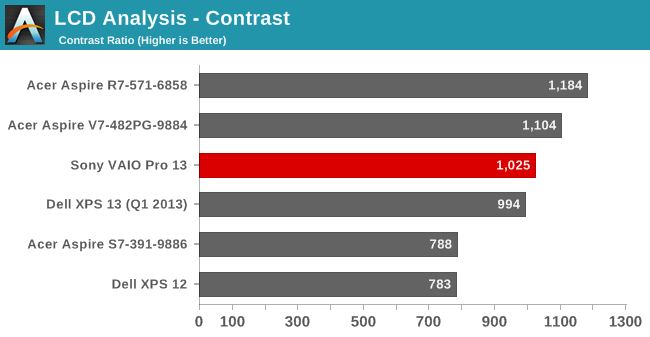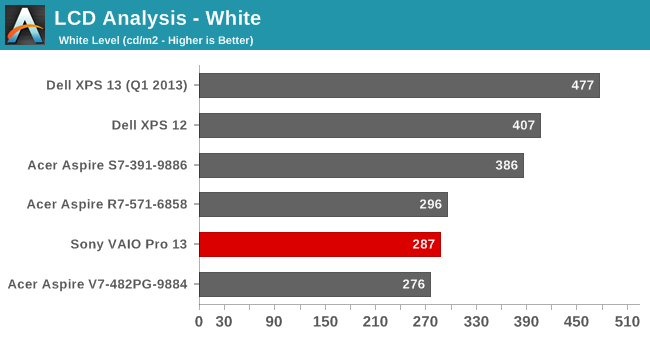Sony VAIO Pro 13: Exceptionally Portable
by Jarred Walton on October 16, 2013 12:00 AM ESTA Great Display
Wrapping up our testing, we have the display along with some figures for temperatures and noise levels. Starting with the display, I actually have a problem with my i1 Display2 colorimeter – it reports numbers, but the calibration is all messed up. I have another colorimeter, an older DTP-94 that still works well, but it doesn't work with ColorEyes Display Pro under 64-bit Windows. What I ended up doing was measuring the white and black levels with the DTP-94 using a separate PC (an old laptop running Windows XP), which also give me contrast, but I don't have Delta E or gamut numbers right now.
At some point we will be moving towards a better test regimen for laptop displays, similar to what we do on tablets and smartphones. Most users don't have a colorimeter, so the out-of-box experience is far more important than the calibrated result – and nearly all displays calibrate fairly well. This will hopefully help to encourage the laptop manufacturers to put more effort into delivering good quality calibrated displays, similar to what we've seen from Apple with their latest iPad, iPhone, iMac, and MacBook Retina products. And with that said, here are the brightness and contrast graphs.



The VAIO Pro 13 has a reasonably bright backlight, but we still would like to see maximum white levels of 400 nits, as that helps with outdoor use. This laptop is so targeted at mobility that the lack of a brighter display could definitely be seen as a drawback. As for black levels and the resulting contrast, the LCD does very well, with a contrast ratio of over 1000:1. Acer's S7 potentially has a slightly better display, based on these results, but I think the colors on the Sony are actually a bit better and hopefully I can get the colorimeter situation sorted out soon enough to update this section. Anyway, I do like the Sony display quite a lot and think it's one of the best aspects of the VAIO Pro 13.
Temperatures and Noise Levels
Considering the apparent throttling that was taking place in some tests – at the very least the CPU/GPU are not running anywhere near maximum Turbo speeds – I was curious to see what the temperatures looked like under load. We've seen many an Ultrabook hit 90C or higher under load, but Sony bucks that trend in a serious way. I don't think it's just the cooling either, as the laptop doesn't get exceptionally loud. Instead, it's Sony's firmware favoring lower Turbo Boost levels in order to keep temperatures down. Here's what we found in our stress testing:

After running our stress test all night (and then some), the maximum package temperature ended up at just 76C. That's a result more than a few desktops would be happy to equal, and we're dealing with an extremely thin chassis. Even the airflow from the vent on the side doesn't feel that hot, and covering it with my hand didn't get uncomfortable – and it didn't increase the noise levels or temperatures either! Instead, clock speeds dropped slightly and the system continued chugging happily along at 76C or less.
As for noise levels, at idle and light loads the fan is off and thus the VAIO Pro 13 is completely silent. Once the CPU temperature hits I think 40C or more, the fan begins to spin, and in most cases it will be at the minimum speed, which results in a noise level of 32dB from a distance of around 18 inches (45cm). The fan speed and resulting noise levels begin ramping up until the fan is running at maximum at 50C or higher, with a resulting noise level of 42dB. It's a gradual ramp in fan speed as well, which is nice to see – a lot of laptops have three or four discrete speeds with a substantial difference in noise levels at each speed. Considering this isn't really a laptop designed for complex computational tasks (not that it can't do some of them, but it's no mobile workstation), most users will find the laptop typically runs at very low fan speeds or even silently.


_thumb.JPG)
_thumb.JPG)
_thumb.JPG)
_thumb.JPG)
_thumb.JPG)
_thumb.jpg)








106 Comments
View All Comments
JarredWalton - Wednesday, October 16, 2013 - link
I don't know about the Tri-luminos tech confusing my colorimeter, but I have verified on a couple laptops that the calibration just looks really off, so I've held off doing any more potentially flawed testing.As for build quality, I noted that it's by design, but I disagree with the design. Yes, it should hold up reasonably well, but laptops like the ASUS U-series, MacBook Air, heck even the Acer S7 all feel better (though the keyboard on the Acer is not at all good in my book). It's a sacrifice of rigidity in favor of being ultra lightweight, and that's fine -- I can live with it and not complain too much. Still, I wish Sony would reinforce the chassis just a bit more. Carbon fiber is not at all heavy, so another layer or two bonded on there would do wonders.
SSD performance is good, and really maximum transfer rates start to become meaningless past a certain point. I would rather have a somewhat slower 256GB SSD than a faster 128GB SSD, simply because I need more capacity. But the VAIO Pro 13 does boot and load programs very fast (other than Windows 8 Apps, which as usual take far too long to load).
teiglin - Wednesday, October 16, 2013 - link
My 256GB unit has a Samsung, and I got 1GB/s sequential read and 825MB/s sequential write just now, if you're curious. Is the Toshiba worse?As for the build quality, I didn't think Jarred was too harsh on it--he mentioned that he liked a more "solid" feel as a matter of preference and not that there's anything inherently wrong with the flexible chassis. I can get a noticeable amount of flex even when mine is closed though, if I squeeze it--again not problematic necessarily, but I can understand if people would like a more rigid design better. Obviously increasing rigidity isn't going to keep the laptop at 2.3lbs.
juhatus - Wednesday, October 16, 2013 - link
When I was ordering, I picked the free 256gb option. I just checked the sony webstore again and now they are offering msata and pci-e options for SSD atleast in Europe. (256gb pci-e upgrade is free btw).I remember the Toshiba being very similar to 840pro speeds, maybe its the msata version. But anyhow its plenty fast. SSD is just something that people should make note because there are alot of different versions Sony ship with these.
SetiroN - Wednesday, October 16, 2013 - link
You really need to re-think your benchmark suite.Who gives a crap about how far an ultraportable goes below 20fps in games.
We need to know how its SSD performs, how long it takes to elaborate files, zip them, copy them. How fast network transfers are. REAL WORLD USE, not freakin' cinebench.
JarredWalton - Wednesday, October 16, 2013 - link
The PCMark scores more or less encapsulate all of the data points you're after. I noted that the SSD is quite fast, and has very good boot times. The CPU results are there just as reference points, and the gaming tests are there to show that, no, this is not a gaming laptop. You'll notice how much time I spent discussing the benchmarks, and that's because for the most part the benchmarks (outside of battery life) simply aren't important. It's more than fast enough. If you have to know how much faster it is than other laptops, you're probably going to want something with a quad-core CPU and a dGPU. Ultrabooks for the most part target the mainstream user that values mobility over performance, so that's the focus of the review.piroroadkill - Wednesday, October 16, 2013 - link
ASUS UX301: with the desired i7-4558U (which is also what I'm interested in) is available in Germany.http://www.amazon.de/Zenbook-UX301LA-Ultrabook-Int...
Since it's publicly available, there's no NDA. I say buy one from Germany and get it shipped. You know people want an indepth review on it.
piroroadkill - Wednesday, October 16, 2013 - link
Also, I mean the i7-4558U is what I'm interested in. The Asus Zenbook Infinity (UX301) does look good, too. I'd love to see it released properly so I could play with the available configurations.However, pretty much any laptop with this CPU that is 13" is worth reviewing.
JarredWalton - Wednesday, October 16, 2013 - link
Now if only I had the money to buy things and have them shipped to me for review....Fatality - Wednesday, October 16, 2013 - link
Great review, But where is the mention of bloatware? Does this thing come with lots of it? I ask this because specs and presence of Bloatware are the primary factors I base my buying decision on. I know a lot of people who do that as well. Has Bloatware? no buy.juhatus - Wednesday, October 16, 2013 - link
I think win8 has generally reduced bloat, but on this vaio pro 13 Sony has put few modern app's and mcafee virus protection (witch i instantly uninstalled and went with win8 defender) Also i think there was the office365 trial included, have not even started that. But id say very little bloat.